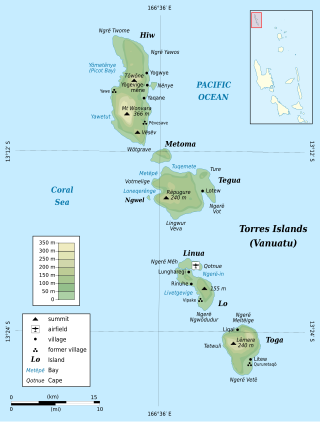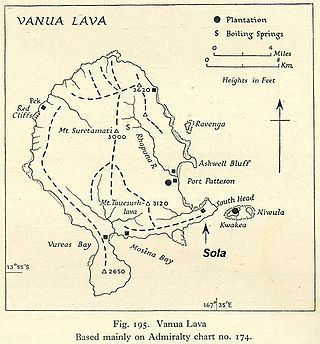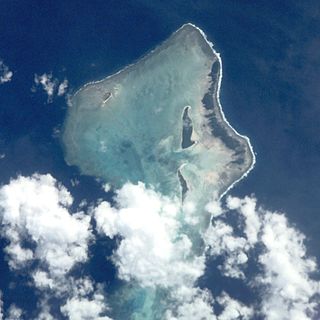
The Lapita culture is the name given to a Neolithic Austronesian people and their distinct material culture, who settled Island Melanesia via a seaborne migration at around 1600 to 500 BCE. The Lapita people are believed to have originated from the northern Philippines, either directly, via the Mariana Islands, or both. They were notable for their distinctive geometric designs on dentate-stamped pottery, which closely resemble the pottery recovered from the Nagsabaran archaeological site in northern Luzon. The Lapita intermarried with the Papuan populations to various degrees, and are the direct ancestors of the Austronesian peoples of Polynesia, eastern Micronesia, and Island Melanesia.

Torba is the northernmost and least populous province of Vanuatu. It consists of the Banks Islands and the Torres Islands.

The Torres Islands are an island chain in the Torba Province of the country of Vanuatu, the country’s northernmost island group. The chain of islands that make up this micro-archipelago straddles the broader cultural boundary between Island Melanesia and several Polynesian outliers located in the neighbouring Solomon Islands. To the island chain’s north is Temotu Province of the Solomon Islands, to its south is Espiritu Santo, and to its southeast are the Banks Islands. To the west, beneath the ocean surface, is the deep Torres Trench, which is the subduction zone between the Australian Plate and Pacific Plate.

Gaua is the largest and second most populous of the Banks Islands in Torba Province in northern Vanuatu. It covers 342 km2.

Vanua Lava is the second largest of the Banks Islands in Torba Province, Vanuatu, after slightly larger Gaua.
Mwotlap is an Oceanic language spoken by about 2,100 people in Vanuatu. The majority of speakers are found on the island of Motalava in the Banks Islands, with smaller communities in the islands of Ra and Vanua Lava, as well as migrant groups in the two main cities of the country, Santo and Port Vila.

Mota Lava or Motalava is an island of the Banks group, in the north of Vanuatu. It forms a single coral system with the small island of Ra.

Mota is an island in the Banks group of northern Vanuatu. Its population – today about 700 people – speak the Mota language, which Christian missionaries of the Anglican Church used as a lingua franca in parts of Melanesia.

Ureparapara is the third largest island in the Banks group of northern Vanuatu, after Gaua and Vanua Lava.
The North Vanuatu languages form a linkage of Southern Oceanic languages spoken in northern Vanuatu.

Kwakéa is an islet located east of Vanua Lava in the Banks Islands, Vanuatu. It has a population of 8 people.

Merelava is an island in the Banks Islands of the Torba Province of northern Vanuatu.
Mwerlap is an Oceanic language spoken in the south of the Banks Islands in Vanuatu.

Vot Tande is an uninhabited islet of the Banks Islands of northern Vanuatu. It is located about 50 km (31 mi) due north of the island of Mota Lava. The islet of Vot Tande has never been inhabited. It is host to thousands of sea birds—especially frigatebirds, which have given their name to the islet. It consists of two islands. The highest point of either of the islands is 64 meters above sea level.
Sola is the capital village of Torba Province in Vanuatu. It is on the island of Vanua Lava.
Mwesen is an Oceanic language spoken in the southeastern area of Vanua Lava Island, in the Banks Islands of northern Vanuatu, by about 10 speakers.
Aplow, Valuwa, or Valuga, is a village located on the eastern part of Mota Lava, in the Banks Islands of Vanuatu. Located close to it is the island's airport, Valua Airport.

Rowa Islands are an uninhabited archipelago in Torba Province of Vanuatu in the Pacific Ocean. The Rowa are a part of larger Banks Islands archipelago. The islands are a natural border between Melanesia and Polynesia; they are one of the most beautiful places in the South Pacific Ocean and an integral part of a vast system of atolls and reefs.
The Narave or Naravé pig is a type of domestic pig native to northern Vanuatu. Narave pigs are pseudohermaphrodite (intersex) male individuals that are kept for ceremonial purposes.










